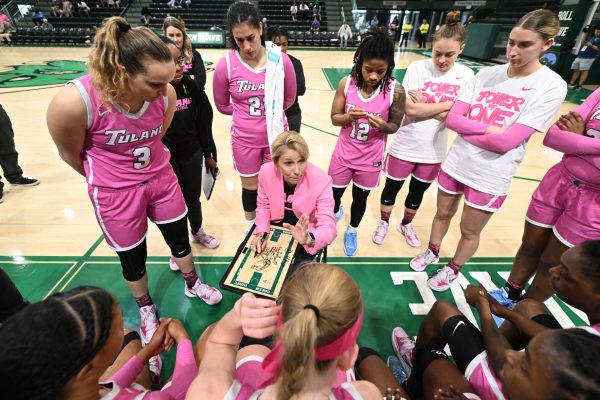New Orleans Film Festival screens experimental gems, classics
October 22, 2016
Opening night, “LBJ” Review by Parker Greenwood | Associate Arcade Editor
Upon arrival at the opening night of New Orleans Film Festival, it was evident that this was the calm before the storm. Setting up along the red carpet were photographers from news outlets like as USA Today, among others. Once the cars began to pull up, photos were being taken non-stop. Pause here, walk here, pose with this person — the commands were coming from everyone, to everyone. Eventually, it became hard to distinguish who was a celebrity and who was not.
The energy was high on Thursday, Oct. 12 at the Orpheum Theater this particular night, for the U.S. premier of the film “LBJ.” The New Orleans Film Festival this year began running that evening, with festivities stretching to Oct. 20. Events for the festival are not limited to one venue, held at locations like the Ace Hotel and the Contemporary Arts Center, as well. Over the course of the festival, hundreds of films are shown.
Many that arrived for the evening’s festivities were festival pass holders, likely to attend many more films over the course of the next nine days. Some were extras in the film, eager to see their face pop up during the movie that evening. Others were the family and friends of the actors that appeared in the film.
Rob Reiner was among the stars to cross the carpet that evening. Reiner, the director of “LBJ,” may be recognized by some for his portrayal of the father of Jordan Belfort in the film “The Wolf of Wall Street.” James Marsden, known for playing Cyclops in the “X-Men” series and Teddy Flood in the new show “Westworld,” was also in attendance, though he himself was not involved in the film. Finally, the last star to walk past the cameras that evening was Woody Harrelson. Harrelson is the lead in “LBJ,” taking on the role of Lyndon B. Johnson.
The heartfelt introductions from members of the New Orleans Film Society began right upon entering the theater. The organizers of the event were both thrilled and emotional about kicking off the festival. Time was taken to present Reiner with the Career Achievement Award, a touching moment as Harrelson delivered the award to the famed director on stage.
While many films chronicling the lives of politicians take themselves extremely seriously, even to the point of alienating much of its audience, “LBJ” does not fall into this trap. While there are undeniably dark moments, as one can expect with a movie depicting the Vice President to President John F. Kennedy, the film offers a different side to Johnson.
Although he was a controversial figure, the film attempts to delve into him as a person more so than a leader. In seeing Johnson cracking inappropriate jokes, making fun of fellow politicians and being insecure of his personality, many of the themes explored in the film were unexpected. The more personable depiction of the politician, a new take on LBJ and politics, while at first disconcerting, turns refreshing as the film progresses. At times, the character paralleled James Carville in the academy award nominated documentary “The War Room.”
“LBJ” is a movie worth watching, even if just for the spectacular job done transforming Harrelson into a political veteran on the silver screen.
Reiner and Harrelson both came and sat on stage to have a question and answer session regarding the making of the film and their dynamic together. Following this, Kinfolk Brass Band, along with stars of the film, led opening night attendees in a second line to the after-party at Palace Café.
“PEOPLE” Review by Josh Axelrod | General Associate Editor
“PEOPLE,” Shane McGoey’s feature film, defies interpretation. Debuting at the New Orleans Film Festival, this movie is a delectable piece of candy for independent film-lovers, wrapped in absurdism, begging to be devoured and resisting at every crackle and crunch.
The 84-minute indie is comprised of six vignettes: a masochistic girl and her psychiatrist discussing her condition, a gay man confronting an obnoxious one-night stand, high school buddies trading insults while watching a boxing match, a hostile couple driving to the hospital, a director arguing with big-wig producers for independent freedom and a collision of each character in a hospital waiting room.
The slice-of-life joy ride begins with a disclaimer: “This film is meant to be viewed in small doses.” Proving to be true, each vignette is jam-packed with symbolism, dicey themes and intricate conversations. Driven mainly by powerful dialogue, the storylines deal with threads of power, love and compassion, control and art all woven into a raggedy, beautiful presentation of the human condition. McGoey seems to suggest that its beauty resides in its imperfection.
The writer-director, who got his start as a production assistant on big-budget features like “Django Unchained” and “Now You See Me”, writes surprisingly strong dialogue and directs with an assured and daring hand. Given the bold concept as a film completely powered by character dynamics and conversation, “PEOPLE” proves to be undeniably watchable.
The fifth vignette about a director clamoring for creative freedom is an intentionally overt meta reference to the conceit of the film. Arguing for the power of the human condition and the intelligence of an audience, the director, portrayed by Mustafa Harris, said, “There are no presets in life; why should film be any different? Just give us the freedom to do what we want and you might get something inspired out of it.” Harris’ enraged tour-de-force monologue is the soaring moment of “PEOPLE.”
Watching the five worlds collide in the final vignette is a gleeful demonstration of McGoey’s capabilities as a poised writer. Bringing home the filmmaker’s sentiment about the ability of art to capture life’s absurdity, “PEOPLE” concludes with an uncertain finale, an homage to existentialist Jean-Paul Sartre and his famous work “No Exit”.
Bolstered by phenomenal performances by mostly local actors, “PEOPLE” is truly an artistic treat for any intrepid viewer. As Harris’ director said, “If you ever had faith in an artist every once in awhile without interrupting or obstructing, they just might surprise you; your audience just might surprise you.”
McGoey’s meta-awareness for his own talent proves to be endearing, not arrogant, and audiences will most likely embrace “PEOPLE” for its off-the-beaten path personality. The precocious filmmaker was right and then some. The artist not only surprises, but he succeeds.
“Contemporary Color” Review by Luo Qi Kong | Staff Reporter
On Oct. 17, the New Orleans Film Festival screened a vibrant performance film, “Contemporary Color,” at the Entergy Giant Screen Theater. The movie combines pop music and the art of color guard.
During the summer of 2015, Barclays Center in Brooklyn held an event called “Contemporary Color,” an unusual combination of iconic musicianship and the sport of color guard. Hardly known outside of its participants, color guard is an art involving dance routines and synchronized movements with flags, rifles and sabers. Led by David Byrne of rock band Talking Heads, 10 high school color guard teams collaborated with performers such as Nelly Furtado, St. Vincent, Ad-Rock and Ira Glass to create original pieces for an equally original show.
Brothers and directors Bill Ross IV and Turner Ross encapsulate the live event in a documentary of the same name. “Contemporary Color,” a feature-length film that follows these performances, as well as the narratives of almost every force behind the show, debuted at the Tribeca Film Festival earlier this year.
“Contemporary Color” utilizes multiple scenes and perspectives, creating dimension beyond a simple concert recording. The Ross brothers include scenes from team and individual practices, moments backstage and conversations among performers; some are light, funnier moments, while others are more evocative, representing the emotion and spirit of color guard.
The film resonates with audiences, even without an initial understanding of the art form, through its layering of conversations and interviews with the theatricality and vibrancy of the performances. Further, viewers almost feel like a part of the show, as cameras focus closely on tearful hugs, adrenaline-fueled cheers and mistakes made on and offstage — it is all “in the moment.” Certain faces of performers become recognizable and friendly. It isn’t difficult to cheer for them, to feel for them and to laugh with them.
Color guard, typically reserved for high school sports games, is much more than crowd-hyping to these performers. Byrne, who produced the film, and the Ross brothers make this undeniably clear through creative visuals and editing.
These visuals, however, are slightly mind-bending at times, as images are layered over already flashy flag-spinning and dancing. The directors often cut away from the performances, leaving them unfinished, or moving back and forth through different scenes. These progressions are initially a bit disjointed, but are repetitive enough to desensitize viewers. To the brothers’ credit, the incompletion of performances actually creates more fluidity in their transitions.
“Contemporary Color” is not simply a documentary or a performance film; it is a fascinating, emotive and whimsical experience unlike most. Oscilloscope Laboratories has announced the feature’s arrival to theaters in early 2017.
Closing night, “Daughters of the Dust” Review by Nurah Lambert | Associate Arcade Editor
A myriad films of various backgrounds and captivating narratives screened at the New Orleans Film Festival 2016, the conclusion of the festival last Thursday. Hundreds of filmmakers from all over the world traveled to New Orleans to celebrate film as an art form and debut their own works, a few of which won festival awards.
A major focus in this year’s festival programming was increasing the diversity of filmmakers and film subjects and retaining the spirit of New Orleans in the overall ambiance of the festival.
“Each new year is kind of a chance to pick films from filmmakers across the world… People want to come here; they want to experience the culture,” festival programming coordinator Jonathon Kieran said. “We hear it over and over again from filmmakers that are returning to New Orleans or are excited to come here for the first time… so the city definitely plays into the flavor of the festival.”
One particular film that stood out was “Daughters of the Dust” written and directed by Julie Dash, screened on the closing night at the Ace Hotel New Orleans. “Daughters of the Dust” chronicles a Gulla Geechee family living on an island right off the coast of South Carolina in 1902, and their struggles with preserving their African roots and culture as they make the decision to migrate north.
The film’s release in 1991 received a good deal of praise, winning the grand jury prize at Sundance Film Festival the year of its launch. The following year, distribution company Kino International picked up the film, making Julie Dash the first African American female director to receive wide distribution of her film. Later in 2004, the Library of Congress inducted “Daughters of the Dust” into the National Film Registry for preservation.
According to NOFF’s executive director, Jolene Pinder, the festival had previously wanted to debut “Daughters of the Dust” for the closing night screening for a few years, but decided to wait until 2016, as this year is the film’s 25th anniversary, a milestone to be celebrated. As a sort of gift to mark its 25th year, the film was recently restored and color corrected.





















Leave a Comment